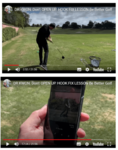ALL effort should be made to PULL the heel and bottom of the club into and under the ** inside quadrant of the ball ** . The swing is performed on an inclined arc and the face is only looking at the intended target during that arc/circle for a inch or two before impact.
It is the turning / rotating torso ( inner circle ) that squares the face, not the hands!
This is why the golf swing is so difficult . It is totally opposite and incompatible to the human brain. It is a hard concept for the brain to grasp bc it is not in its subconscious. It is a learned conscious task . It becomes much easier to learn when you understand this.
It is the turning / rotating torso ( inner circle ) that squares the face, not the hands!
This is why the golf swing is so difficult . It is totally opposite and incompatible to the human brain. It is a hard concept for the brain to grasp bc it is not in its subconscious. It is a learned conscious task . It becomes much easier to learn when you understand this.





